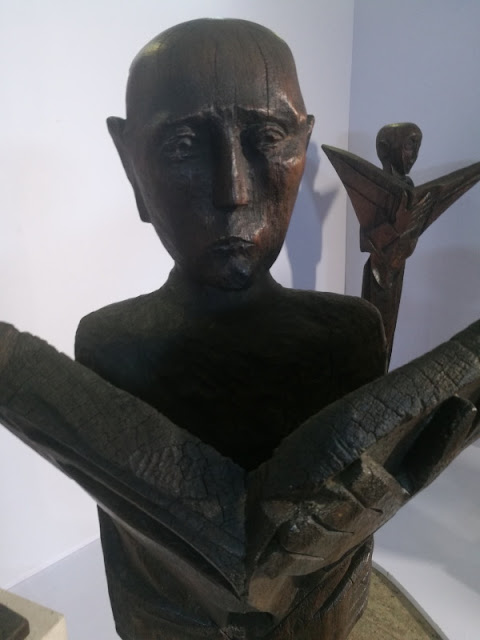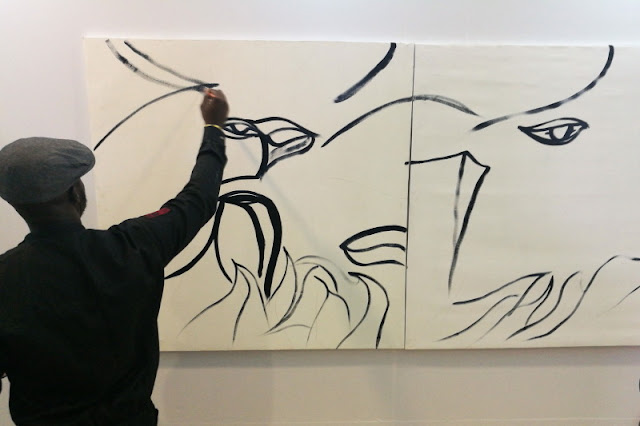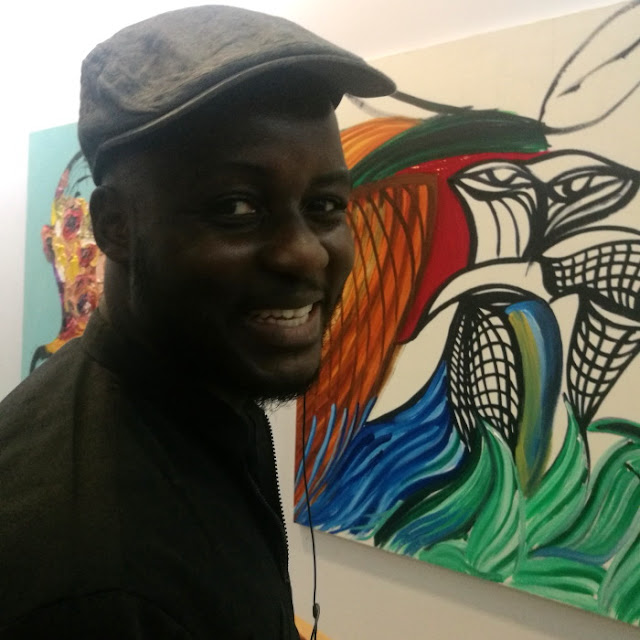 |
| Oluseye and Lakin Ogunbanwo: Project One |
November 3rd was the first day of ART X. Still under the leadership of Tokini Peterside, it opened with an afternoon reserved to collectors and an evening to VIPs. Same location as the
ART X Lagos first edition, with equal parking inferno, but somehow the same old trick worked to park right by the building.
A great show this year, largely dominated by Nigerian artists and galleries. However South Africa, Kenya, Ghana and Francophone Africa were also represented.
Most importantly for the VIPs, Perrier-Jouet was a sponsor and their champagne was served chilled from their beautiful bottles adorned with art-deco flowers.
 |
| Ben Enwonwu's 1960 wooden sculptures commissioned by the Daily Mirror |
On the ground floor, seven Ben Enwonwu's wooden statues, carved in the 60s for the Daily Mirror, were presented for the first time to the public, courtesy of Access Bank. They represented newspaper readers. Interestingly from afar they had an air of angels.
On the first floor, the sponsor's lounge had cosy rectangular seats and a stage, where some events would take place over the next two days. It was decorated with two giant metal sculpture from Olu Amoda.
 |
| Olu Amoda's metal work |
Prints of Fela's LP covers by Lemi Ghariokwu were displayed on one side of the lobby while on the side a selection of photographs by Rahima Gambo addressed the issue of girls' access to education, particularly in the predominantly muslim Northern Nigeria.
On the second floor was the main exhibition hall. In the lobby, Yaw Owusu, a ghanaian artist, was presenting works made of old ghanian cent coins (which he had difficulties to procure from the central bank, as they were no longer in circulation). The coins, minted in Canada, came in different level of oxidation and where clustered by shades of color to represent land maps from the colonial era. The connection between coins and maps was a reference to the zones of affluence that could be clearly demarcated geographically.
 |
| Yaw Owusu: the cent collector |
 |
| Yaw Owusu's work made of Ghanian cent coins |
In the main hall, established Nigerian galleries were exhibiting Nigerian artists.
Sandra Obiago presented, among others, Tony Nsofor whose oil on canvas are a mixture of rich colors and minimalist deconstructed lines, and Modupeola Fadugba with her pastel colored pieces in oil and acrylic on burned paper.
Oluseye (conceptual artist) and Lakin Ogunbanwo (photographer) showed Project One. It is a body of work celebrating black male nudity in a mix of western aesthetic, Yoruba traditional artworks and decorative ritual motives of the Suri tribe. It was interesting to see people's reaction in front of these nudes.
 |
| Rom Isichei |
Rom Isichei had a new series of woman portraits, very sensual. As usual he had a critical look at the modern habits of our vain materialistic society as highlighted by the propensity of people to take selfies with their smartphones.
 |
| (L to R) Ugoma Adegoke, the Emir of Kano Muhammad Sanusi II, Tokini Peterside |
Bloom Art and Ugoma Adegoke presented Olu Ajayi with large oil canvas in light blue and grey. Muraino Oyelami with a series of modestly sized oil on wood representing either girls or landscape in his own figurative style.
 |
| Chinwe Uwatse and her Uli inspired watercolours |
Chinwe Uwatse had a series of watercolours on handmade paper, with colours inspired by South of France where she resides part of the year. Her lines are inspired by the Uli traditional art which uses motifs and symbol for magic purposes, they are representation of the essence of life from nature. This art form comes from Eastern Nigeria.
 |
| Polly Alakija and her works |
Polly Alakija displayed several of her paintings in her very personal style, powerful colours with rough textures. Her lines are stylized, focusing on everyday scenes in Nigeria. Some of them evoke to me the lines and simplicity of popular art from the former USSR, albeit with cheerier colours! She was commissioned by Lagos State to paint the pillars of Falomo bridge around the Falomo roundabout in Ikoyi.
A corner, curated by the A Whitespace Creative Agency, was dedicated to live performances to give an idea of the creative process execution. One of the artist was Dipo Doherty.
 |
| Dipo Doherty painting live (1/2): the beginning |
 |
| Dipo Doherty painting live (2/2) |











Comments
Post a Comment